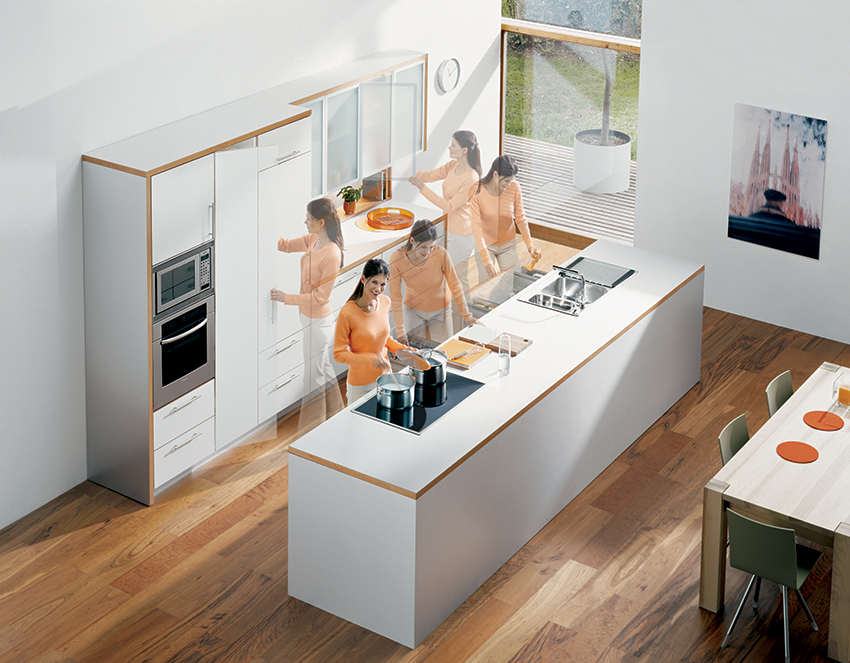
Ergonomics focuses on the relationship between human beings and the functional elements of a system. Kitchen ergonomics deals with how kitchen design has adapted to make working in a kitchen more simplistic and effortless per se yet rendering an exclusive signature appreciating the value of the realty. Pioneers in this way of design methodology are Austrian kitchen fittings manufacturer Blum and their trade and implementation partner Häfele India Pvt ltd. Their fittings designs products based on five key zones namely the consumables zone, and the non-consumables zone, the cleaning zone, the preparation zone, the cooking zone arranged consecutively to ensure a smooth work flow. That's ergonomics at its very best! Ergonomics plays a significant role in Indian kitchen design since it is availability of adequate space and not disposable income which are major challenges for today's interior designers. India is however just opening up to the concept of an intelligently designed kitchen as it is still perceived as an unnecessary luxury and the domain of the wealthy. However with the growing economy will come the need for more well designed lifespaces. In the coming decade, it will not just be design but intelligent design that will gain dominance in the kitchen design and planning segment.
What is ideally the principle of designing a kitchen?'
According to the concept of DYNAMIC SPACE Study conducted by Blum a kitchen should be planned keeping the following points in mind. These are: zone planning, storage space, work flow, ergonomics and optimal access. DYNAMIC SPACE optimizes the existing space and significantly improves workflow. Zone planning should be used to define the proper allocation and equipment for the five most important work areas. These are separate areas for consumables, non-consumables, preparation, cooking and cleaning.
According to Dynamic Space planning, a properly planned kitchen saves time and shortens distances. In an average household kitchen, there are about 100 kitchen zone changes per day, up to 30 journeys to and from the table. Approximately 50 activities are carried out within the kitchen zones. Various appliances are used nearly 30 times each day. Doors drawers and pull-outs are opened and closed over 80 times. This amounts to thousands of hours of work throughout the life of a kitchen. With Dynamic Space planning these journeys are significantly reduced.
DYNAMIC SPACE improves storage space utilization – enhancing, both ergonomics and access. To gain this extra space, one should always use full extension drawer pull outs. More usable space is also gained when using higher back and side walls in pull-outs. Full extension drawer pull-outs also provide total access and an unhindered view of contents.
DYNAMIC SPACE also stands for internal organization; the versatile ORGA-LINE inner dividing system converts drawers and pull-outs into perfect locations to store items. Organization options remain flexible and can be removed and rearranged to suit individual storage requirements.
The use of shelves in Base cabinets is poor in ergonomic terms: it makes it very difficult for you to find items since you don't have an overview of the entire cabinet contents. Quite often one has to bend or stretch and also shift things to locate items. Full extension drawer pull-outs have the advantage of allowing one to see and access items all the way at the back in contrast to single extension. This provides a complete view of all items in the pull-outs making them easily accessible.
According to DYNAMIC SPACE planning, frequently used items should be stored in easy-to-reach pull-outs near work areas as well as on the first level in the wall cabinet. Seldom-used items end up on the top level of wall cabinets and at the bottom level of base cabinets. This simple principle saves a great deal of time during daily kitchen work.
The normal aging process can cause movement to become difficult over time. Back and knee problems can occur. Changing eyesight can make kitchen work difficult. Even a pregnancy changes the requirements for kitchen utilization. The DYNAMIC SPACE concept takes these factors into account and thus gives you a kitchen that will function for years to come.
Which is the ideal kitchen design layout (L Shaped, U shaped, Galley, Island etc) and why? Please describe the merits and demerits of each layout quoting examples.
There is no such thing as an ideal kitchen layout. A layout that works in one place not necessarily would be effective in another situation. The layout depends solely on the requirement of the kitchen space available. However the most popular design layout is the L shaped, as it has an excellent use of space as everything is visible at one glance. There being no obstacle in the workflow, the process of cooking and cleaning is simplified.
A word on dimensions (horizontal and vertical) and their intricacies.
In the world of modular kitchens dimensions play a key role and should be strictly adhered to in order to achieve standardization. First and foremost before starting the construction there should be a concrete plan designed around a theme. The most crucial dimensions are those of the depths for the base units and the heights of the tall units and suspended cabinets. The depth of the base unit decides how much of working space and leg room one will have in a kitchen. It's the crucial part in designing an island kitchen. The height of the suspended cabinet will decide what type of lift up system or flap fitting the designer would use. Common depth for nominal lengths for the Indian client would range from 350mm to 650mm. For drawers a full extension is always preferable to a single extension as it gives much more accessibility. For tall units the height should be selected keeping in mind the extra storage it provides. For this a height of 1900mm and above as provided by the HSA rotary in Häfele's range of tall units serves just the purpose.
Lighting parameters for kitchens. Are LEDs the ideal lighting solutions?
Lighting in the drawers, cabinets, plinth area or countertop should add to both task and accent. Perfect lighting over dinner tables should provide you with adequate lighting for homework, hobbies, business, dining or entertaining. When the sink is equipped with the adequate lighting, it helps you to see that the dishes are washed and the pots and pans are clean with little effort. Under cabinet lighting is ideal for countertops. The usage of the right inconspicuous lighting solutions by Häfele will highlight your cabinetry, while adding a warm, comfortable atmosphere to your kitchen.
What are the different criteria to be considered while choosing kitchen paraphernalia such as countertops, cabinets, hobs, chimneys, sinks etc.?
Countertops: The countertop is the most expensive material in the kitchen and gives the kitchen its special look. Today there are many options for countertops ranging from granite, quartz composites, artificial polymers to even recycled glass composite surfaces. First and foremost it depends on the looks and the amount of money you are willing to shell out. Granite is cheaper than composites in India due to its abundance as compared to the western world. However granite has a natural surface: what this means is what you see when the rock face is cut is what you get. It's also porous and prone to allow bacterial growth due to water absorption. Composites however allow for almost negligible porosity cancelling out bacterial growth and zero water absorption and the color texture and pattern can be controlled and monitored to get the exact pattern the catalog promises. Quartz being the third hardest material in nature lends its strength and surface hardness to the surface. Composites provide a mixture of the best properties of all the materials used to create them. However working with composite surfaces needs a bit of experience and there is an added cost for the special glue that's required.

Cabinets are like the skin of the kitchen and should be chosen with utmost care. There are many materials available for making cabinets. Cabinets are generally made out of wood. There are also alternative materials such as MDF (medium density fiber) boards, HDF (high density fiber) boards, honey comb structures etc. The shutters can range from the same material as the cabinet or could be fabricated with aluminum profiles. There are many new methods of constructing cabinets without the hassle of using a hammer and a nail. The minifix corner connecters offered both by Häfele and Blum are a very neat connection solution.
Kitchen Appliance: Stylish design, functional features and quality are the 3 principal factors when choosing an appliance. Keeping this in mind Häfele has carefully chosen its supply partners, Falmec, Bertazzoni I Bertazzoni - LaGermania, Liebherr, Asko to ensure that your needs are met with our offering of attractive cooker hoods, cooking ranges, refrigeration and washing and drying options. Each partner offers both practical and durable products in both traditional and modern designs. Our range of built-in applications allows you to maintain clean, flush and stylish cabinet fronts on show.
Storage Solutions: Creation of functional space in the kitchen is very important for families today, especially with the increase in open-plan living. Häfele identifies with this growing need and has carefully selected the latest innovations available to help you organize your storage with attractive, functional and space-efficient corner solutions, larder/pantry pull-outs and drawer baskets.
Kitchen Sinks: Häfele offers a variety of sink materials, from Blanco's patented and scratch-free SILGRANIT™ to rust resistant Stainless Steel, along with fitting options and varied bowl sizes each offering their own advantages.















